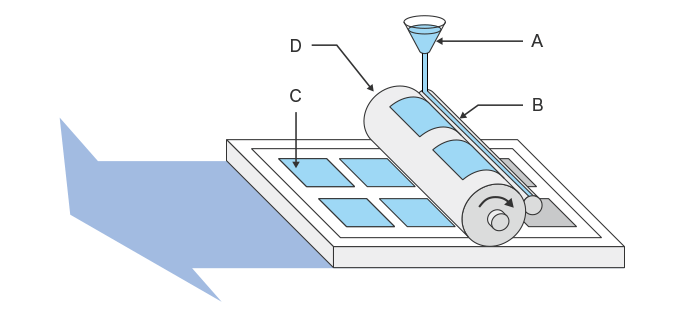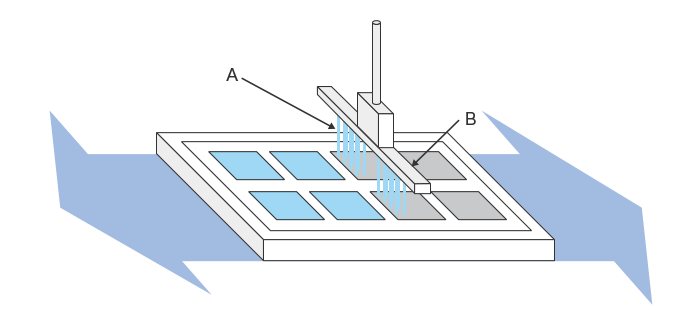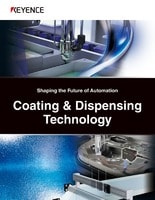Inkjet Coating
Overview of inkjet coaters
Inkjet coaters are based on the same mechanism as injet printers (for high-resolution on-demand printing, etc.). Inkjet coating devices emit a jet of paint or coating material that is deposited on the target, allowing for small-quantity, precision pattern coating with minimum loss of material.
Compared with typical coaters, the greatest advantage of inkjet systems is the ability of precision pattern coating directly from CAD or other data without making plates (masks).
Comparison between inkjet coaters and other systems
- Example of a typical roll coater (gravure roll)
- Plate making is required for transferring a pattern. Monitoring irregularities and thickness is essential to maintaining a uniform coating.
-

- A. Ink
- B. Gravure roll
- C. Glass substrate
- D. Transfer roll
- Example of an inkjet coater
- A pattern is deposited by the jet of ink, which eliminates the need for plate making. Patterning can be made with CAD data. Quality is less affected by the size of substrate.
-

- A. Ink
- B. Inkjet print head
In addition to the above, inkjet coaters provide the following major advantages.
- Highly uniform film thickness
- Functional film coating on high-precision narrow bezels
- Accurate landing and block coating
- Wiring drawing of irregular forms, micro wiring, and micro chips
Present state of inkjet coaters
Advancements in inkjet technology
Conventional inkjet systems faced a variety of challenges, including clogged nozzles and unstable material feeds. Even slight dirtiness on the surface of the inkjet head nozzle may prevent discharge due to clogging, or cause deformation of the nozzle. If, for example, nano-ink containing metallic components dries on the nozzle surface, metalized nanoparticles can block the nozzle and prevent stable discharge.
To prevent such problems, improvements have been made such as functions for preventing drying on the nozzle surface, or a fluororesin coating (liquid-repellent coating) on the nozzle surface that prevents the nozzle from becoming wet with ink regardless of whether the ink is water-based or oil-based. With the improvement of stability through these efforts, inkjet technology has been introduced to a wider variety of applications. Studies for achieving even greater stability in mass production are also still underway.
Applications and advantages of inkjet coaters
Coating applications
Inkjet coaters have become widely popular attracting a wide range of attention for applications. Replacement of conventional coating systems for printed wiring drawing on PCBs or photoresist coating on semiconductor wafers is possible, as well as precision coating of insulating film for touch panels, TFT wiring patterns, organic EL (OELD) luminescent materials, PCL materials, QD display materials, and conductive polymer materials.
Advantages in on-demand applications
For on-demand applications in development and prototyping phases, inkjet coaters eliminate the time and costs required for plate making. Prototypes of coated patterns can be tested quickly, which is the greatest advantage. For example, if digital design data is available, users can make a prototype by coating a precise circuit pattern immediately. They can then modify the data to make another prototype and test it. This dramatically improves development speeds.






